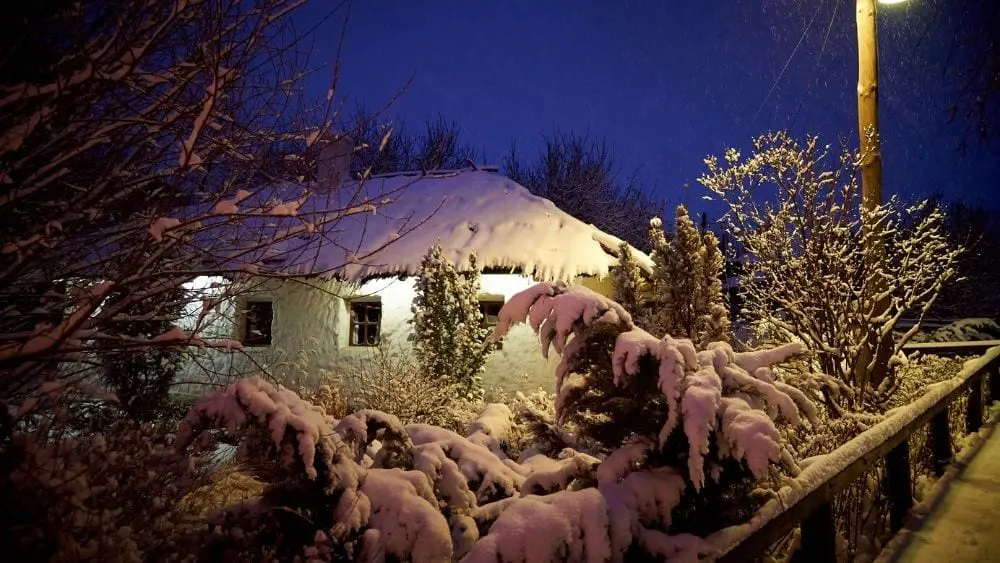
An element as basic as your lawn should not be something to stress over. It should be a simple set up with minimal upkeep, allowing you more time to enjoy your yard. However, seasonal changes can be hard on your grass. If your lawn becomes damaged due to the elements, there are ways to lessen the effects and avoid permanent damage.
The good news: Even if “permanent” damage persists, you always have the option to reseed or resod to thicken the grass again for new growth. But if you are aware of a weather change coming your way, you can use the following tips and tricks to prepare in advance. And hopefully, you can avoid replanting and maintain a healthy lawn even in extreme conditions.
Icy Winters
While the winter often means barren trees and dormancy, your yard can still flourish if cared for correctly. Regular maintenance in preparation for long, cold winter months is key. This involves implementing a regular mowing schedule to maintain a healthy grass height, providing an appropriate amount of fertilizer and avoiding high traffic in grassy areas not protected by snow.
Mow Regularly, But Not Too Often
Be sure to keep your grass at a recommended medium height, about 2.5 inches in the wintertime, and resist cutting too often. When you cut the lawn too low and too often, this can lead to a multitude of other issues that can cost you in the long run. Cutting the grass too often causes immense stress on the plant itself by shearing down the leaf surface area needed to generate photosynthesis to keep the lawn alive and growing.
Fertilize
Adding a fertilizer before winter arrives will help to grow a lush, healthy lawn when the plant springs back after the dormant months. Some homeowners apply fertilizer at the end of summer, but you can also add it prior to the first freeze in your area, and be sure to use the correct amount for your lawn size.
Reduce Irrigation
Fall is a good time to reduce or stop irrigation. Without the sun beating down and the heat constantly drying out the leaves, there is less of a need for consistent watering. If you live in a climate that freezes, it may be best to stop watering altogether. If you water the lawn and then it freezes overnight, this can lead to more intense issues later on.
Prepare for Snow or Frost
If you live in an environment where snow is a given, make sure to avoid plowing the snow on your yard as it can lead to patchy grass. The snow acts as an insulator by protecting the grass from harsh elements during the dormant season, and will melt away when it’s time for your lawn to come back to life in the spring.
If your area is not predisposed to snow, you should still keep off your grass when the frosty temperatures set in. When the lawn frosts over, the blades of grass freeze and water molecules expand within the leaves. Stepping on these frozen leaves may create a satisfying crunch, but it actually breaks the leaf as the expanded water molecules slice the fragile blades, causing irreparable damage. If you must walk across your grass after an overnight frost, try lightly watering the grass to melt the frost prior to stepping onto the lawn.
Extreme Summers
The intense summer sun can be particularly harmful to your grass. By maintaining a regular mowing schedule, watering correctly and efficiently and lessening the foot traffic on the lawn, you can keep your yard looking its best even in the sweltering summer heat.
Again, Mow Regularly, But Not Too Often
Keeping your lawn at a slightly taller height (usually about 3 inches is sufficient) is important in the summer to help shade the soil and retain moisture. Additionally, growing taller grass encourages a deeper root growth, giving the plant access to richer soil when the shallow ground dries in the summer heat.
Good lawn mower maintenance is a key to achieving a healthy lawn as well. Dull blades tend to shred the grass, giving the leaves brown, dead tips. Keep the blades sharp and set the mower to a slightly taller height to keep your lawn looking fresh and green throughout the summer months.
Water Correctly and Efficiently
Watering the lawn once a day, even at a small amount, can actually have detrimental effects on your turf. It creates a dependency in the plant, which has been found to stunt root growth as the plant adapts to gulping up the small splash of water each morning. Additionally, evaporation happens quicker than the plant can take in the water, meaning more water was paid for and wasted when it never reached the roots.
Watering is most efficient in the early morning between 6 a.m. and 10 a.m., before the sun steals it away through evaporation. Consider the climate in which you live to determine your watering amount and schedule, but usually one inch once a week or a half-inch twice a week in the mornings is sufficient.
Stay off the Lawn
In dry conditions, stepping on grass can beat down the plant, leading to soil compaction and preventing air from getting to the grass roots. Try to avoid walking or playing on grass in the summers when the climate is dry and hot.
Drought Conditions
Droughts pose a serious threat to your lawn and other plant life in your yard. Communities prone to drought may set restrictions on how much and how often homeowners are permitted to water. Keeping this in mind, there are a few options to help keep your turf looking healthy and alive.
Lessen the Lawn
You can simply lessen the turf space in your yard. Options such as xeriscaping can reduce the need for water and fertilizer by using native plants that are adapted to drought and dry conditions. Homeowners can thoughtfully plan out their yard, grouping plants by maintenance needs in specific hydrozones, and add tolerant, low-lying plants in areas where they can expect heavy foot traffic.
Compost
Chemical fertilizers cause lawns to grow more quickly and therefore require more water. In droughts, homeowners might try to forego this effort without access to the necessary water source. Rather than deprive your soil of nutrients, try using compost or organic fertilizer to keep your lawn healthy without the hastened growth.
Water Source From Runoff
With watering restrictions in effect in most areas predisposed to drought, it may be beneficial to consider maintaining your own water source that collects from runoff. This can be done by placing a rain barrel under gutter downspouts or window air conditioners. Using a water barrel can save you money and keep your yard looking its best without breaking any local restrictions.
Keep Your Yard Looking Sharp
While seasonal changes pose a strong threat to the well-being of turf lawns, this is a challenge that can be overcome with the right amount of planning and preparation. By maintaining healthy height through regular mowing, infrequent watering and less foot traffic, you can maintain a beautiful lawn throughout the year that is sure to impress.

Melanie Theriault is a writer, counselor, and lifelong learner. She holds a B.A. in Sociology from Southwestern University, where she discovered her passion for fostering human connection through storytelling.
 5 Easy Home Organization Projects
5 Easy Home Organization Projects